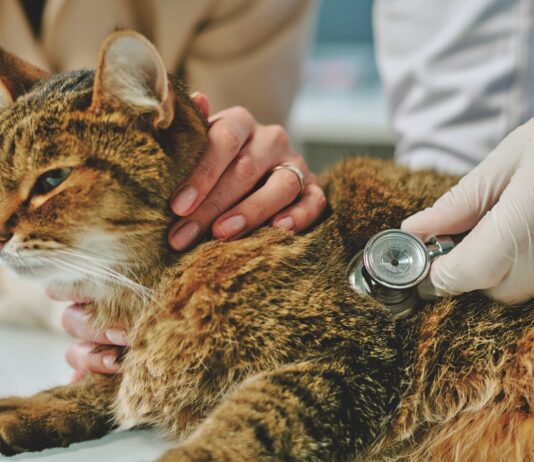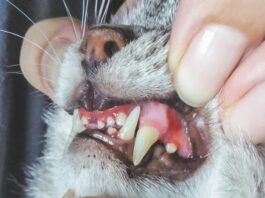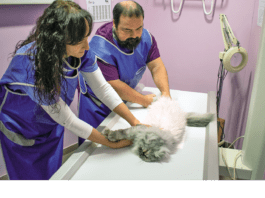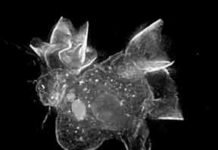Tracking a Parasite as it Invades the Brain
It’s common knowledge that pregnant women should avoid litter boxes to avoid contact with toxoplasma. The parasite found in cat feces can cause toxoplasmosis, a disease that may cause a number of developmental abnormalities in developing fetuses and neurologic, ocular and other potentially severe problems in people with compromised immune systems. Research in recent years has shown an association between toxoplasmosis and schizophrenia, depression and anxiety. Studies also suggest that the disease can influence levels of human aggression, extroversion and risk-taking. Now a study by the Karolinska Institute in Sweden suggests a mechanism by which toxoplasma may influence the behavior of its hosts.
Ask Elizabeth: March 2013
As you know, we cats are very sensitive creatures, but in your case, as with other cats with feline hypersensitivity syndrome (FHS), this sensitivity seems to be ratcheted up. FHS is a recognized syndrome in the feline world, although the definitive cause is not clear. While it is not, in and of itself, believed to seriously affect overall health or longevity, a few important points regarding this unusual behavioral syndrome are worth making, especially for our human friends who are commonly puzzled by its manifestations. FHS, also variably referred to as rolling skin syndrome and atypical neurodermatitis, is characterized by dramatic twitching or rippling of the skin, most commonly on the back between the middle of the spine and the base of the tail or in the flank region, with intermittent jerking of the body and exaggerated tail movements.
You Can Prevent This Serious Disease
If you’ve resisted brushing your cat’s teeth, knowing how strenuously he’s likely to object, consider this: Periodontal disease, an often painful inflammation of the gums that can result in bone loss and destruction of oral tissue, is extremely common. In fact, it’s the most prevalent disease in companion animals and can pose serious health threats. “Periodontitis has been shown to play a role in such health problems as cardiovascular disease and diabetes,” says dental specialist Santiago Peralta, DVM, a Lecturer in Dentistry and Oral Surgery at the Cornell University College of Veterinary Medicine. This disease is, however, entirely preventable, according to the American Veterinary Dental College (AVDC). The best way to prevent periodontitis is by regular brushing and professional dental care.
Toward More Accurate Diagnoses of Sarcomas
Researchers at North Carolina State University are hoping for a breakthrough in a study designed to distinguish spontaneous sarcomas from injection site-associated sarcomas (ISASs). Each year about 22,000 cats in the U.S. appear to develop sarcomas, or malignant tumors, at the site of a vaccination or other injection, according to the Morris Animal Foundation, which is funding the study. The more aggressive ISASs often recur. Identifying a sarcoma in its early stages “could provide crucial information to help guide the owner and veterinarian as the best approach to treatment, and in the longer term, help us to understand why these tumors occur,” says Rachael Thomas, Ph.D., leader of the research team
A Deadly Threat to Outdoor Cats
Cats whose breed developed in frigid areas of the world are likely to tolerate cold weather better than cats whose origins can be traced to more temperate regions. But even the fattest, furriest Maine coon will have only a slight edge over a trim, thin-coated Siamese when it comes to prolonged exposure to the biting winds, ice, snow and sleet that come with winter.
Cuterebra Infestation Can Be Deadly
Most owners know the parasites that can bedevil their cats, including fleas, ticks, mites and an abundance of worms. A lesser-known parasite, with far greater impact, is cuterebra (kyüt-ә-`rç-brә). They’re larva from adult botflies that can burrow under a cat’s skin or, more alarmingly, enter through the nose and migrate to the brain. The threat of infestation is not widely known for two reasons, says parasitologist Dwight Bowman, Ph.D., professor in the Department of Microbiology and Immunology at Cornell University College of Veterinary Medicine. “It tends to be more rural than urban and suburban.” And the flies are prevalent only in the Western and Northeast U.S., and Southeastern Canada.
A Commitment to Improving Well-being
Imagine veterinarians being able to sterilize feral cats by vaccination instead of surgery. Or to identify the connection between a relatively benign form of feline coronavirus and feline infectious peritonitis, which is nearly always fatal, with the hope of finding ways to diagnose and combat it. Or discover how and why vaccine-associated sarcomas may trigger DNA damage in some cats and how this damage may be used to predict which cases of the sarcomas are amenable to chemotherapy. These are just three of the many scientific studies funded by the Cornell Feline Health Center where, under the guidance of Director Colin Parrish, Ph.D., Professor of Virology, the goal of bettering the health of cats continues to be the focus and commitment, as it has been since the center opened its doors in 1974.
Short Takes: September 2012
Biologists at the Royal Veterinary College in London may have discovered the reason for the cheetah’s record as the fastest living land mammal. Researchers at the college’s Structure and Motion Laboratory compared the cheetah’s gait to that of racing Greyhounds, whose speed tops out at 37 miles per hour. The big cats have been clocked at 64 miles per hour. “Cheetahs and Greyhounds are known to use a rotary gallop [in which the limbs fall in circular sequence around the body] and physically they are remarkably similar, yet there is this bewitching difference in maximum speed,” says researcher Alan Wilson, Bsc., Ph.d.
Understand Intestinal Disorders
Of all feline health problems, intestinal disorders rank among those most frequently treated by veterinarians at local clinics and large referral hospitals throughout the U.S. According to Melanie Craven, BVM, an internist and researcher in gastroenterology at Cornell University’s College of Veterinary Medicine, vomiting, diarrhea and dramatic weight loss are the most common signs of feline intestinal disease in cats. However, she notes, subtler signs such as lethargy and appetite fluctuations can also suggest the presence of an intestinal disorder.
Grants to Study FIP and Other Diseases
Investigations into potential treatments for feline infectious peritonitis (FIP), hypertrophic cardiomyopathy and chronic kidney disease were among ten projects selected by the Winn Feline Foundation from 44 proposals to receive $174,018 in funding. The investigation by Belgium researchers to evaluate the efficacy of a treatment for feline infectious peritonitis received the most funding at $24,962.
Short Takes: May 2012
Diagnostic decision-making can sometimes present a challenge to veterinary clinicians when they are presented with an apparently healthy adult cat with a heart murmur. Murmurs can be associated with cardiac disease — though some studies have also identified benign causes of murmurs in cats. Auscultation alone will not differentiate the cause of the murmur and additional diagnostics will be required. Feline murmurs can be inducible (upon physical provocation such as stress, fear or pain) or non-inducible (continuously present). A high percentage of cats with inducible murmurs appear to have no evidence of structural heart disease.
Veterinary Hospice: An Option?
For many years, Katherine Goldberg, DVM, worked in veterinary critical and intensive care units. As she found herself becoming increasingly interested in the stories behind the emergencies, she was moved to make a difference for terminally ill pets. In 2010, she founded Whole Animal Veterinary Hospice Services, a practice whose mission is to provide “compassionate care in the comfort of your home.” She now spends most of her time doing just that. We spoke with Dr. Goldberg at a recent presentation in Ithaca, NY, where her practice is based. What exactly is veterinary hospice? The word “hospice” — which has the same root as “hospitality” — originally meant a place of shelter for weary travelers. In 1969, Elizabeth Kubler-Ross’s groundbreaking book On Death and Dying helped to jumpstart the human hospice movement, and the term “hospice” began to be used to describe specialized care for dying people.














